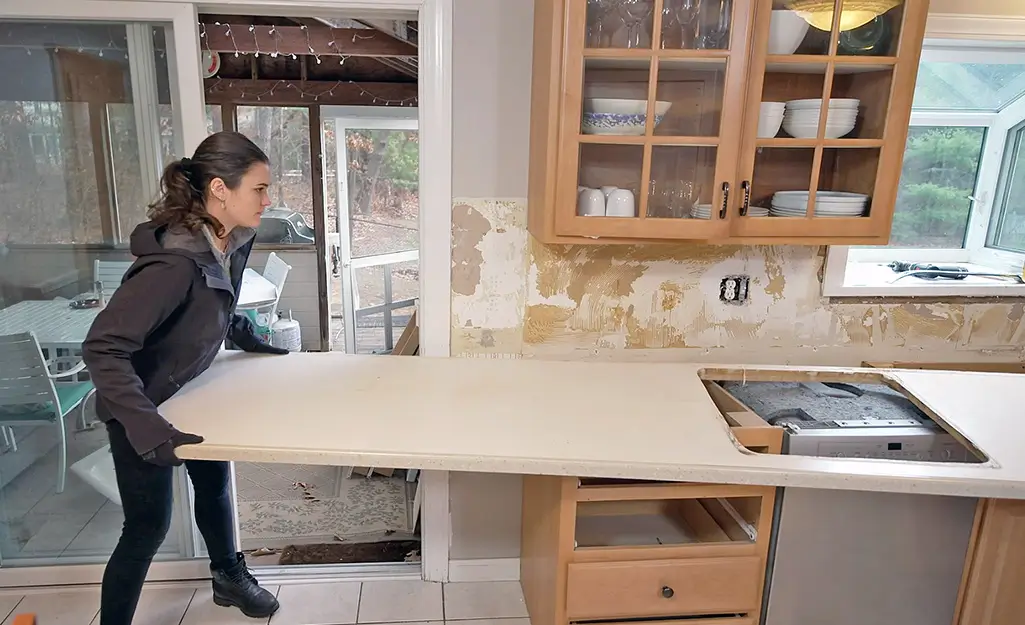Written by Nyla Thompson
Founder of DecorifyIt and a certified home improvement specialist with over 15 years of hands-on renovation experience. Nyla shares practical, budget-conscious strategies to help homeowners create stylish, functional spaces that truly feel like home.
Thinking about replacing your old worktop? One of the most common questions I get from homeowners is: Can you install countertops yourself, or should you hire a pro? The answer isn’t a simple yes or no—it depends on the material, your DIY experience, and how polished you want the finish to be. After working on dozens of kitchen remodels over the past 15 years, including both DIY and contractor-led jobs, I’ve seen exactly where homeowners succeed—and where things often go wrong. Here’s what you need to know.
What’s Actually Involved in Countertop Installation?
Replacing a countertop isn’t just about laying a surface over cabinets. I’ve personally replaced laminate and butcher block tops in everything from compact rental kitchens to full family home upgrades, and each job required:
- Precise measuring and cutting, often with a jigsaw and router
- Checking for level cabinets, which is critical before fitting anything
- Using the right adhesive and sealants for long-term durability
- Finishing off edges and seams so the joinery doesn’t look homemade
Even experienced DIYers underestimate how technical this process can be.
Can You Install Countertops Yourself?
Absolutely—if you’re working with lightweight materials like laminate. I’ve guided plenty of clients and readers through DIY countertop installations, particularly for small kitchens or utility rooms. For those willing to follow instructions carefully and work patiently, it’s a manageable project.
You’ll need:
- A circular saw or jigsaw for accurate cuts
- Level, clamps, and measuring tape
- Tools for edge finishing, like a file or trim router
- Protective gloves and goggles
- Adhesive rated for countertops
When I installed a butcher block in my own kitchen, I spent a full weekend dry-fitting, sealing, and securing every edge. It was satisfying—but also stressful, because every cut had to be spot-on. I made sure to match the standard countertop height for a proper fit and comfortable use.
Pros of DIY Installation
💷 Cost Savings
Hiring a professional countertop installer can cost £500 or more in the UK. By going the DIY route, I’ve helped clients save anywhere from £200 to £400—especially when reusing cabinets or removing the old top themselves.
🕰️ Flexibility
You can work around your own schedule and take your time. I often tell homeowners: if you’re not rushed, your quality improves tenfold.
🧰 Skill Building
There’s nothing quite like the satisfaction of completing a beginner countertop project and knowing you did it yourself.
Where DIY Gets Risky
- Measurements must be exact
I once had a client cut a laminate top just 2cm short—ruining the entire slab. There’s no room for error here. - Cabinets need to be perfectly level
During one of my earliest installs, I skipped this step—and the result was a sloped join that had to be redone. - The right tools matter
Using the wrong blade to cut laminate countertop can cause chipping or melting. I always recommend a fine-tooth blade and slow speed. - Seam finishing takes practice
Seams and joints need to be tight and clean, or they’ll look uneven—and worse, collect moisture.
When a Pro Is the Smarter Option
Through years of seeing both DIY and professional jobs, I strongly recommend hiring a professional if:
- You’re installing granite, quartz, or marble
- Your layout includes multiple corners, seams, or cutouts
- You don’t have tools, time, or someone to help lift
- You want guaranteed, fast results
Professionals also know how countertops are attached for long-term durability, and they handle seams and joints so they’re nearly invisible. I’ve seen this firsthand when working with contractors on high-end homes in Surrey and Essex—those seamless finishes just aren’t easy to achieve without years of experience.
How to Choose Between DIY and Pro
Ask yourself:
- Am I confident with power tools?
- Do I know how to check for level base cabinets?
- Have I installed any surface before?
- Can I live with small imperfections if things go wrong?
If your answers lean “no,” trust me—go with a pro. The stress of DIY can outweigh the savings if you’re not prepared.
Can You Reuse Old Countertops or Sinks?
Yes—but with caution. In one kitchen remodel I helped with in Bradford, we successfully reused a solid oak worktop after carefully removing it from the original cabinets. Laminate tops, however, often break during removal. The sink? It depends on cutout compatibility.
As for what goes first: sink or countertop—always fit the countertop first, then the sink. It ensures a clean, flush fit and avoids gaps.
DIY vs Professional: Real-World Cost Breakdown
Here’s an actual case from a reader who installed a laminate top in a rental:
- Laminate worktop: £160
- Tools and supplies: £90
- Time: 2 full days
- Total: £250
They saved roughly £300 compared to hiring out—but admitted it took much longer than expected and involved a lot of YouTube watching. Meanwhile, a quartz install I oversaw with a contractor came in at £850—but was completed in just 6 hours.
Quick Comparison Table
| Feature | DIY | Professional |
|---|---|---|
| Cost | £200–£300 | £500–£900+ |
| Time | 1–3 days | 4–8 hours |
| Skill Needed | High (for accurate cutting) | None |
| Tools Needed | Yes (saw, clamps, adhesive) | No |
| Materials Suitable | Laminate, wood | Any (granite, quartz, marble) |
| Quality Risk | Medium–High | Low |
Final Thoughts
So—can you install countertops yourself? Yes, but only if you’re confident, patient, and using easy-to-work-with materials like laminate or butcher block. If you’re going for high-end stone or want zero mistakes, call a pro. After 15 years of seeing both approaches, I always advise clients to weigh their skill level, budget, and time before jumping in.
Whether you go solo or bring in the experts, remember: a well-fitted countertop can completely transform your kitchen.

